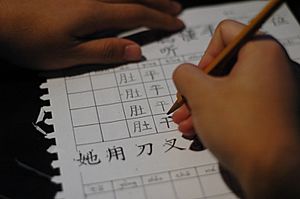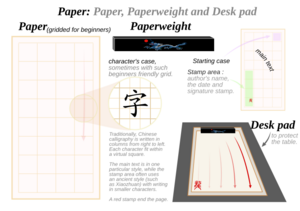Chinese school facts for kids
Quick facts for kids Chinese school |
|||||||||||
|---|---|---|---|---|---|---|---|---|---|---|---|

A student practices writing Chinese characters
|
|||||||||||
| Traditional Chinese | 中文學校 | ||||||||||
| Simplified Chinese | 中文学校 | ||||||||||
|
|||||||||||
A Chinese school (simplified Chinese: 中文学校; traditional Chinese: 中文學校; pinyin: zhōngwén xuéxiào; Cantonese Yale: jūngmán hohk'haauh) is a special kind of school. It's set up to teach different types of Chinese language, especially Mandarin and Cantonese. These schools also teach many cool parts of Chinese culture. This can include Chinese art, beautiful writing called calligraphy, history, and even martial arts!
Sometimes, a Chinese school is its own place. Other times, it's a program inside a bigger school. Many Chinese schools aim to keep traditional Chinese language and culture alive. In 2007, a newspaper called USA Today said Chinese was "the new English." This shows how important the language is becoming.
In recent years, the Chinese government has given money to some schools in the U.S. This has made some people wonder if it affects what is taught in these schools.
Contents
What Do Chinese Schools Teach?
The lessons at a Chinese school can be different depending on the school. But usually, they teach the Standard Chinese language. They also teach many parts of Chinese culture. This often includes Chinese art, Chinese history, and Chinese martial arts.
Learning the Chinese Language
Nearly 1.2 billion people speak Chinese around the world. That's about 16% of everyone! Chinese schools usually teach both how to write and how to speak Chinese.
China's economy is growing very fast. Because of this, learning Mandarin is becoming very popular. More and more young people in Western countries, like the UK and the U.S., are studying it.
One important tool used in Chinese schools is called Pinyin. This is a special system that helps you read Chinese words. It uses the Latin alphabet (like the one we use for English) to show how Chinese characters sound. The Chinese government created Pinyin in the 1950s. It became an international standard in 1982.
The Art of Chinese Calligraphy
When you learn to write Chinese in these schools, you follow methods from China called Shūfǎ (書法). This means "the way of writing." Lessons often focus on the correct way to make each stroke. You also repeat strokes to practice.
Schools teach how words are related based on their "Chinese radicals." Many words come from ideas connected to a certain topic. The order of strokes is also very important. It helps you find Chinese words in a dictionary.
Exploring Chinese Art
Chinese art taught in these schools follows techniques from Chinese painting. Here are two main styles:
- Gong-bi (工筆): This style means "meticulous." It uses very detailed brushstrokes to show things exactly. Gong-bi paintings are often brightly colored. They usually show people or tell a story. Artists working for the royal court often used this style. Paintings of birds and flowers were also often done in Gong-bi.
- Ink and wash painting (水墨): This style is also called "literati painting." It was one of the "four arts" for Chinese scholars. In theory, gentlemen practiced this art. This style is also known as "xie yi" (寫意), which means freehand style.
Learning Chinese Martial Arts
Chinese martial arts are sometimes called "kung fu." These are different fighting styles that have developed in China over many centuries. Chinese schools often offer these programs. Martial arts are a key part of Chinese culture.
Sometimes, other martial arts like karate and tae kwon do are taught. Even though they started in other parts of Asia, they are sometimes included as part of Chinese heritage.
Big Celebrations
Chinese New Year
Many Chinese schools hold a special event for Chinese New Year. This is a very important Chinese festival. It celebrates the start of a new year on the Chinese calendar. It's also known as the Spring Festival.
Chinese New Year celebrations usually last a long time. They start on Chinese New Year's Eve. This is the last day of the last month on the Chinese calendar. The celebrations end on the Lantern Festival, which is the 15th day of the first month. This makes it the longest festival in the Chinese calendar! The first day of the New Year can fall between January 21 and February 20.
Category:Chinese-language educationCategory:History of immigration to the United StatesCategory:Asian-American culture



